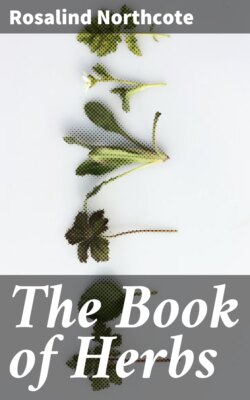Читать книгу The Book of Herbs - Rosalind Northcote - Страница 10
На сайте Литреса книга снята с продажи.
Borage (Borago officinalis).
ОглавлениеTable of Contents
Here is sweet water, and borage for blending,
Comfort and courage to drink to your fill.
N. Hopper.
This reference to Borage touches a long-lived belief—
I, borage,
Give courage—
briefly states one reason of its popularity, which has lasted ever since Pliny praised the plant; besides this, it was supposed to exhilarate the spirits and drive away melancholy. De Gubernatis[12] only found one charge against it, amid universal praise, and this is in a Tuscan ninnerella, a cradle song, where it is accused of frightening a baby! But this evidence is absolutely unsupported by any tradition, and he considers it worthless. Borage was sometimes called Bugloss by the old writers.[13] In 1810 Dr. Thornton calls it “one of the four grand cardiac plants,” but shows a lamentable lack of faith himself. Dr. Fernie[14] finds that Borage has a “cucumber-like odour,” and that its reputed powers of “refreshing” and “invigorating” are not all due to the imagination; “The fresh juice,” he says, “affords thirty per cent. of nitrate of potash. Thornton had already commented on the nitre it contains, and to prove this he advises that the dried plant be thrown on the fire, when it emits a sort of coruscation, with a slight detonation.” Personal experience teaches that this is easier to observe if the plant is set on fire and burned by itself. Borage might be grown for the sake of its lovely blue flowers alone, and Parkinson gives it a place in his “Earthly Paradise,” because, though it is “wholly in a manner spent for Physicall properties or for the Pot, yet the flowers have alwaies been interposed among the flowers of women’s needle-work”—a practice which would add to the beauty of modern embroidery. He adds that the flowers “of gentlewomen are candid for comfits,” showing that they did not allow sentiment to soar uncontrolled! Bees love borage, and it yields excellent honey, yet another reason for growing it. In the early part of the nineteenth century the young tops were still sometimes boiled for a pot-herb, but in the present day, if used at all, it is put into claret-cup. Till quite lately it was an ingredient in “cool tankards” of wine or cider.
[12] La Mythologie des Plantes.
[13] Family Herbal, 1810.
[14] Herbal Simples, 1895.
